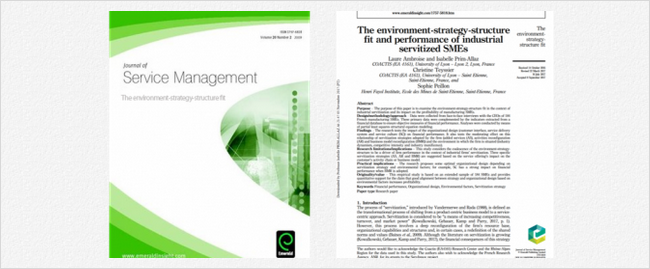Laure Ambroise, Isabelle Prim-Allaz, Christine Teyssier et Sophie Peillon publient un article dans Journal of Service Management
Laure Ambroise, Isabelle Prim-Allaz, Christine Teyssier et Sophie Peillon, chercheuses à Coactis, publient un article intitulé « The environment-strategy-structure fit and performance of industrialized servitized SMEs » dans le Journal of Service Management.
Cette recherche résulte du projet ANR ServInnov et repose sur la base de données ‘plan PME’ développée par le laboratoire Coactis avec la région Auvergne-Rhône-Alpes. Elle s’intéresse aux conditions de réussite du développement des offres de services par les PME industrielles. Elle propose une approche revisitée des stratégies de service proposées par les entreprises industrielles et montre l’intérêt d’un bon alignement entre la stratégie de service choisie, le design organisationnel et l’environnement pour permettre à chaque stratégie de service d’être performante.
Référence :
Ambroise L., Prim-Allaz I., Teyssier C. &Peillon S. (2017), The environment-strategy-structure fit and performance of industrialized servitized SMEs, Journal of Service Management. Early preview : https://doi.org/10.1108/JOSM-10-2016-0276
Abstract
Purpose – This study aims to examine the environment-strategy-structure fit in the context of industrial servitization and its impact on the profitability of manufacturing SMEs.
Design/methodology/approach – Data were collected from face-to-face interviews with the CEOs of 184 French manufacturing SMEs. These primary data were complemented by indicators extracted from a financial database to ensure objective measures of financial performance. Analyses were conducted by means of PLS structural equation modelling.
Findings – The research tests the impact of the organizational design (Customer Interface, Service Delivery System and Service Culture) on financial performance. It also tests the moderating effect on this relationship of servitization strategies adopted by the firm (Added Services, Activities Reconfiguration and Business Model Reconfiguration) and the environment in which the firm is situated (Industry Dynamism, Competitive Intensity and Industry Munificence).
Research implications/limitations – This study considers the coalescence of the environment-strategy-structure to be a driver of firm performance in the context of industrial firms’ servitization. Three specific servitization strategies (Added Services – Activities Reconfiguration – Business Model Reconfiguration) are suggested based on the service offering’s impact on the customer’s activity chain or business model.
Practical implications – The research proposes some optimal organizational design depending on servitization strategy and environmental factors; for example, Service Culture has a strong impact on financial performance when Business Model Reconfiguration is adopted.
Originality/value – This empirical study is based on an extended sample of 184 SMEs and provides quantitative support for the claim that good alignment between strategy and organizational design based on environmental factors increases profitability.
Keywords – Servitization Strategy; Financial Performance; Organizational Design; Environmental factors.
Paper type – Researchpaper

